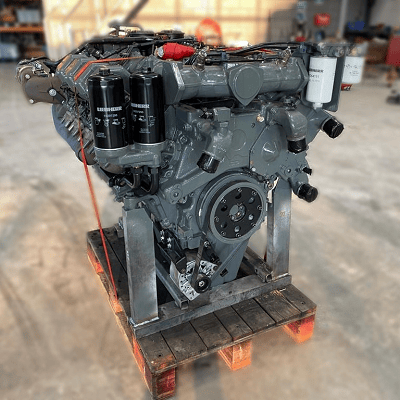The process of a dyno test on a Liebherr engine

When it comes to heavy machinery, reliability and power are paramount. Liebherr, a name synonymous with innovation and excellence in engineering, stands tall as a pioneer in the realm of heavy equipment and machinery. From towering cranes to robust excavators, Liebherr’s engineering prowess extends to the heart of these machines. We delve into the world of dyno testing a Liebherr engine, uncovering the meticulous process behind unleashing the raw power concealed within.
The foundation of excellence
Before we embark on the journey of dyno testing, it’s crucial to understand the foundation upon which Liebherr engines are built. With decades of engineering expertise and commitment to quality, Liebherr engines are crafted to withstand the most demanding environment and deliver unparalleled performance. Each component is meticulously designed and rigorously tested to ensure reliability, efficiency and longevity.
The process
1 Preparation: The engine undergoes meticulous preparation before being mounted onto the dynamo meter. This includes ensuring all connections are secure, fluids are filled to the appropriate levels, and sensors are properly calibrated.
2 Mounting: The engine is carefully mounted onto the dynamometer, a specialized device designed to simulate real-world operating conditions. Precision is paramount during this step to ensure accurate results.
3 Initial checks: Once mounted, a series of initial checks are conducted to verify proper alignment, connection integrity, and functionality of all engine systems.
4 Warm-up: The engine is started and allowed to warm up to operating temperature. This ensures consistent results and minimizes the risk of damage during testing.
5 Baseline testing: With the engine warmed up , baseline tests are conducted to establish initial performance metrics. This includes measuring power output, torque, fuel consumption, and emissions at various RPM levels.
6 Load testing: The engine is subjected to progressively increasing loads to simulate different operating conditions, such as idle, partial load and full load. This allows engineers to assess performance across the entire operating range and identify any potential issues or optimization.
7 Data analysis: Throughout the testing process, data is continuously collected and analyzed in real-time. Advanced instrumentation and software are used to monitor performance metrics and identify trends or anomalies.
8 Optimazation: Based on the data analysis, adjustments may be made to optimize engine performance. This could involve fine-tuning fuel injection timing, adjusting air-fuel ratios, or optimize turbocharger boost pressure.
9 Validation: Once testing is complete, the results are meticulously reviewed and validated against predetermined criteria and specifications. Any deviations or anomalies are thoroughly investigated to ensure accuracy and reliability.
10 Reporting: Finally, a comprehensive report is generated detailing the results of the dyno testing, including performance metrics, observations, and any recommendations for further optimization or refinement.
The outcome of dyno testing
Dyno testing a Liebherr engine is more than just a routine procedure – it’s a testament to the unwavering commitment to excellence that defines Liebherr’s engineering philosophy. By subjecting their engines to rigorous testing and analysis, Liebherr ensures that each engine delivers the uncompromising performance, reliability, and efficiency that customers expect.
In conclusion, dyno testing a Liebherr engine is not just about measuring power output. It’s about unlocking the true potential of these remarkable engines and ensuring they exceed expectations in the most challenging environments imaginable.
Double Spindle Turning Milling Composite Machine Tool
Double spindle butt lathe is an advanced CNC lathe with high in the machine tool industry. Its main feature is that it can achieve multiple types of turning and drilling processing on one machine tool, improving productivity and machining accuracy.
I. Structure composition
The main structural composition of double spindle docking lathe includes machine body, CNC system, tool holder, toolholder, spindle, collet, turning center, tool, etc. Among them, the machine tool body is the foundation of the whole lathe, mainly responsible for supporting and fixing each component to ensure the stability of the machine tool. The CNC control system is the intelligent brain of the lathe, which centrally controls and manages the operation and machining process of the lathe. The tool holder and tool shank are used to hold and fix the tool and cut the workpiece. The spindle and collet are the core parts of the lathe, which are responsible for driving the workpiece and cutting tools, etc. for machining.II. Working Principle
The working principle of double spindle docking lathe is similar to that of ordinary lathe, but it has double spindle structure. Its spindles can run together or work independently to process two workpieces at the same time, thus realizing multiple tasks on one machine tool. This lathe adopts advanced CNC technology, which can freely adjust the processing parameters as needed and highly automate its working process.III. Application Scenario
The twin-spindle docking lathe is widely used in the processing of various materials such as metals and non-metals in the industrial field. Its main application scenarios include:(1) Aerospace field: manufacturing various aerospace engines, accessories and parts.
(2)Automobile manufacturing industry: used to produce various cars, trucks and motor vehicle parts.
(3) Medical devices: for the production of various medical devices and medical equipment.
(4) Electronics field: for the production of a variety of electronic product housings and parts.
(5) Machinery field: for the production of various machinery, industrial equipment and parts.
In a word, double spindle butt lathe is a kind of advanced CNC lathe that is standardized, modularized and equipped with advanced mechanical, electrical, hydraulic, pneumatic and computer control technologies. Its high efficiency, high precision and high automation make it have great advantages in terms of return on investment, production efficiency and product quality.
Double Spindle Turning Milling Composite Machine Tool,Dual Spindle Cnc,Dual Spindle Lathe,Dual Spindle Cnc Lathe
Ningbo Yien Machinery Co., Ltd , https://www.yiencnc.com